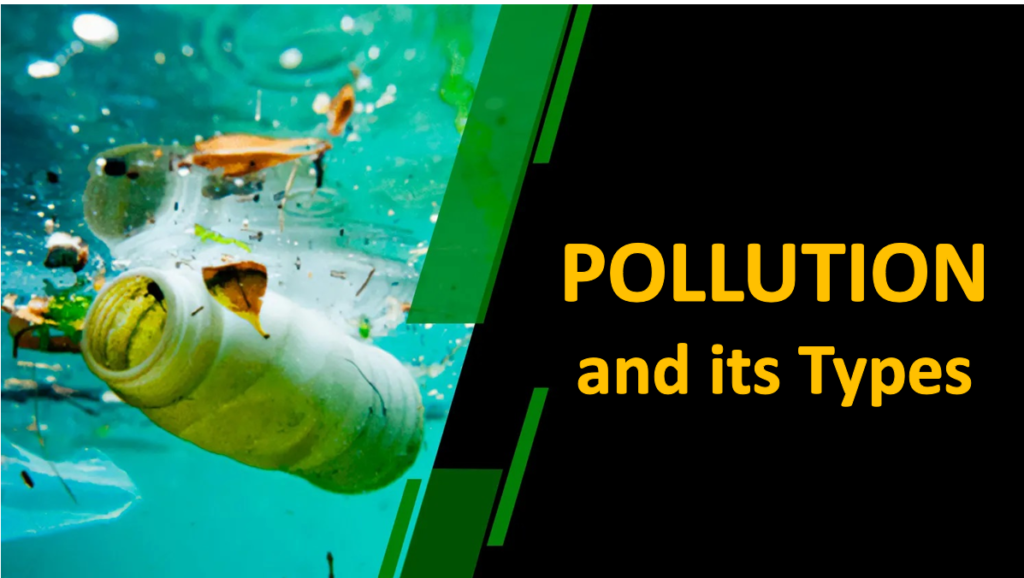The introduction of hazardous elements into the environment is pollution. Natural pollutants include volcanic ash, for example. They can also be brought about by human activities, such as factory runoff or waste. The quality of the air, water, and land is harmed by pollutants. Many things that are useful to people produce pollution.
- Cars spew pollutants from their exhaust pipes. Burning coal to create electricity pollutes the air. Industries and homes generate garbage and sewage that can pollute the land and water. Pesticides—chemical poisons used to kill weeds and insects—seep into waterways and harm wildlife.
One of the biggest problem faced society today world is environmental pollution, which affects humans and other living organisms. Although urban areas are usually more polluted than the countryside, pollution can spread to remote places where no people live. For example, pesticides and other chemicals have been found in the Antarctic ice sheet. In the middle of the northern Pacific Ocean, a huge collection of microscopic plastic particles forms what is known as the Great Pacific Garbage Patch.
What is Environmental Pollution?
The word ‘Pollution’ is derived from the Latin word ‘Polluere’ / ‘polutus’, which “to get spoil or to make unclean or impure or unhealthy.” Environmental pollution can be defined as any unfavorable alteration of environment largely as result of human activities. Pollutants are the materials, which causes adverse effects on the natural quality of any components of the environment. Examples: Smoke, chemicals etc.
The biological components of the Earth are contaminated by environmental pollution, which has a negative effect on standard ecological processes. Environmental pollution refers to any unnatural and harmful changes in any dimension (such as the physical, chemical, and biological aspects of any ecosystem component) that have the potential to have dangerous consequences on a variety of life forms and property.
Characteristics of Pollutants
One of the largest problem faced by society today is environmental pollution, which affects humans and other living organisms. Human activities harm the environment because they contaminate the soil we use to grow plants, the water we drink, and the air we breathe. The characteristics of Pollutants are as follow:
- They are long-distance travellers and capable of spreading to the entire globe in relatively short time.
- They are persistent and long-lasting.
- They accumulate both in atmosphere and animal tissues
Pollution: Classification of Pollutants
The pollutants can be classified on the following basis:
On the basis of Source
- Natural Pollutants: These are generated in nature by natural processes and phenomena. Example: Volcanic ash.
- Artificial or Man-made pollutants: These are produced by human activities such as production of Co2 and CO by combustion of fossil fuels, use of pesticides, waste generation etc.
On the basis of form
- Primary Pollutants: Example: DDT and plastics.
- Secondary pollutants: Example: peroxyacetyl nitrate (PAN)
On the basis of their natural disposal
- Biodegradable pollutants: These are natural organic substances which can be decomposed naturally by bacteria etc. Example: Food waste.
- Non-biodegradable pollutants: These are pollutants which do not get decomposed naturally. Example: plastic.
Types of Pollution
There are primarily 7 types of environmental contamination that can happen on Earth. The sources, impacts, and preventative actions for each of the pollution categories mentioned in this article are detailed below.

Air Pollution
When chemicals, particulate matter, or gases are released into the air and have the potential to harm people or the environment, it is known as “Air Pollution”. Air pollution is caused by solid particles and gases present in the atmosphere such as Coal, dry grass, dry-farm waste, and leaves utilized as domestic fuels in villages also generate harmful gases in the atmosphere.
Air pollution and Your Health: Air Pollution causes diseases of the lungs and respiratory systems, as well as increases the risk of heart disease in people. Additionally, it might cause bronchitis and asthma. The environment may also be impacted since it produces more greenhouse emissions.
To reduce air pollution, households and businesses should run on better-designed machinery and smokeless fuels.
- To keep the ecosystem in balance and control the impact of the rising greenhouse gases, afforestation—the planting of additional trees—should be promoted.
- The National Ambient Air Quality Standards (NAAQS) and the National Air Quality Monitoring Program (NAMP) are two more actions the government took to reduce air pollution.
Water Pollution
When hazardous substances, such as chemical contaminants, untreated waste discharges, and sewage, are dumped into rivers, lakes, and seas, water pollution results. Farming practices that use excessive amounts of fertilizers and pesticides, which can harm water bodies, are among the origins of Water Pollution. The reasons of environmental water pollution are as follows:
- Industrial effluents enter oceans.
- Agricultural pollutants are dumped into the water bodies.
- Disposal of radioactive substances into seawater.
- Trading of marine.
- Offshore oil rigs.
- Recreational sports.
- Sewage is disposed of into the sea by rivers.
When the amount of mercury in the water grows, water pollution has the potential to lead to both dropsy illness in fish and Minamata disease in people. Additionally, it causes eutrophication (an oversupply of nutrients) and biological amplification (an increase in the concentration of harmful substances).
By changing the methods used to prevent water pollution from the environment, water usage must be controlled or decreased. For reuse, wastewater needs to undergo thorough treatment.
Soil Pollution
When levels of pollutants or harmful compounds rise and build up on the soil surface, it results in environmental pollution of the soil. The following substances contribute to Soil Pollution:
- Inorganic ions and metals
- Salts (e.g., carbonates, nitrates, phosphates, sulfates)
- Organic compounds (such as alcohols, DNA, fatty acids, hydrocarbons, lipids, proteins, PAHs, etc.)
Salinity and decreased soil fertility are two impacts of pollution in the soil. Drains become blocked as a result, which causes the release of unpleasant scents and gases. We need to cease using plastic if we want to reduce soil pollution. To prevent soil pollution, plastic use should be decreased, and sewage should be properly treated before being used as fertilizer on planted areas.
Thermal Pollution
Thermal pollution is the loss of water quality caused by any procedure that raises the temperature of the water around it. When industrial enterprises and power plants use water as a coolant, environmental contamination results. Some of the sources of thermal pollution are industrial boilers, coal-fired power plants, oil refineries, nuclear and electric power plants, and steel-melting companies.
The repercussions of thermal pollution include a reduction in the amount of dissolved oxygen in the water, the extinction of numerous fish and invertebrate species, and the destruction of their eggs that have been laid in the water bodies.
There are certain scientific methods for preventing thermal environmental pollution, such as building cooling ponds or buildings and creating artificial lakes. These lakes are created by humans and offer a potential substitute for natural water supplies for cooling power plants.
Noise Pollution
Unwanted sound, or noise pollution, causes excruciating ear agony. Decibels (dB) are used to measure sound levels; noise levels about 90 dB produce auricular weakening, while sound levels beyond 100 dB might result in permanent hearing loss. The sound of the ship’s water contributes to Noise Pollution by interfering with whales’ ability to navigate and even destroying aquatic animals.
- The factories’ machines generate whistling, grinding, and thundering sounds.
- Exploding rocks and earth, drilling tube wells, heavy earth-moving machinery, and ventilation fans at construction locations cause this type of pollution.
- Other causes of this environmental pollution are the sound of automobile horns and the high sound of loudspeakers.
Noise pollution can lead to high blood pressure, stress-related illnesses, speech impediment, hearing loss, unbalanced sleep patterns, and decreased productivity.
By keeping roadside cars in good condition and employing soundproof technology in busy areas, noise pollution can be reduced. Horn usage on roads should be kept to a minimum. Silencers must be installed on industrial machinery and automobiles to prevent excessive noise.
Light Pollution
Light pollution, also known as photo pollution and frequently seen in urban areas, is caused by the additional light in the night sky. Because it ruins the ecology, this kind of environmental pollution makes it difficult to discern between day and night.
Artificial indoor or outdoor light, street lighting, display and advertisement lighting, security lights, luminous athletic arenas, etc. are the culprits. The effects of light pollution on ecosystems, the night sky, astronomical research, astronomical observations, energy waste, and the health of living things are all negative.
Light pollution has an adverse effect on wildlife rhythms, increases carbon dioxide levels, disrupts sleep cycles, and distorts the appearance of stars in the night sky.
- Lights should be turned off whenever unused, especially at night.
- The overutilization of indoor lights should be minimized.
- Lights should be pointed towards the ground whenever you are going outside your home.
Radioactive Pollution
When radioactive substances are released into the environment during nuclear explosions, nuclear weapon testing, the manufacture and decommissioning of nuclear weapons, the mining of radioactive ores, the handling and disposal of radioactive waste, and accidents at nuclear power plants, it is referred to as radioactive pollution.
It is produced by uranium mining, nuclear power plants, the development and testing of military weapons, as well as by academic institutions and healthcare facilities that use radioactive materials in their research and treatment plans.
Disposal of radioactive waste is extremely difficult since it can linger in the environment for thousands of years. Groundwater, surface water, and marine resources are at risk from toxins that have been carelessly or accidentally released.
Effects of Environmental Pollution
All living things are susceptible to the dangers of environmental contamination. Wheezing, coughing, respiratory problems, and other conditions can all be brought on by air pollution. It can also irritate the skin, nose, and throat.
- Asthma, heart attacks, and other respiratory issues can all be brought on by air pollution.
- Acid rain, ozone layer degradation, and global warming are further effects of air pollution.
- When consumed by people, environmental pollution of water can kill aquatic life and possibly result in diseases like typhoid and jaundice.
- Water that has been contaminated has very little dissolved oxygen (DO), making it unsafe to consume.
- The quality of plants cultivated can be impacted by soil or land contamination, which might interfere with the subsurface life of microorganisms.
Environmental Pollution Control Measures
Different types of environmental contamination can be controlled by implementing some appropriate actions. For the protection of people and other living things, pollution management is necessary.
- Given that plastic takes years to disintegrate in the ecosystem, its usage should be outlawed.
- Both interior and outdoor lighting should not be used needlessly.
- Crackers ought to be prohibited since they significantly harm the environment.
- Reusable materials can help reduce environmental pollution, and they should be vigorously promoted and recycled for use in the future.
- More people should choose public transportation because it consumes less energy and gas.
- Since fans consume less electricity and energy to run, they should be used more frequently than air conditioners.







